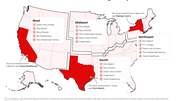Blog
Food halls are no longer trendy
Food halls used to be the "next big thing," but as more pop up, they are fighting to differentiate themselves.

August 6, 2019
Submitted by Foodworks
In cities around the United States, food halls are popping up in record numbers, bringing diners the convenience and ease of the once-popular American food court with modern, artisanal flair. At a time when consumers are seeking convenience and Instagram-worthy experiences in the same meal, food halls are the restaurant industry's perfect answer.
But as more players enter the game, food halls will face a coming challenge. They will have to find ways to start differentiating themselves not just from traditional brick-and-mortar restaurants but from each other. According to a 2018 report by real estate brokers Cushman & Wakefield, food halls are headed for more rapid growth, popping up in new markets and multiplying in cities where they already exist.
Originating in Europe and Asia, the food hall trend comes to the United States at a time of escalating rents and labor costs in cities like Los Angeles and New York. For small and midsize restaurants, food halls present an opportunity to expand business and reach new audiences without the immense cost of opening another brick-and-mortar location. Even for successful larger restaurants, a lower-cost second location can serve as a test bed for new menus or changes to their business models.
For diners, the combination of variety and convenience is the bedrock of the food hall's appeal. Families or groups of co-workers can venture to the same lunch spot and still find something that pleases everyone, making meals a shared and compromise-free experience rather than a lonely wait in another sandwich-shop line. And with many food halls boasting modern and attractive interiors— a fitting backdrop to vendors' innovative and eye-catching menu items — food halls have capitalized on consumers' social-media craze to transform their dining spaces into destinations. At places like La Centrale in Miami, millennial-friendly white marble tables and greenery-adorned ceilings send a clear signal that this isn't just a place for grab-and-go lunch. It is a site for culinary exploration, socializing and indulging in the experience.
How to stand out
To stand out and attract customers, many food halls have begun partnering with celebrity chefs and creating viral food concepts. At Time Out Market New York, visitors can find internet-famous edible cookie dough or stop by the trendy Avocaderia. Other food halls like Graze & Gather in Denver have seized on the growth of the freelance economy to create dual-concept, co-working spaces where guests can grab a breakfast burrito or craft pizza while working in an open and communal environment.
Still, for many food halls, differentiating themselves will be about returning to the roots of the food hall model's success: an emphasis on local and artisanal foods. While variety and convenience may be a food hall's greatest draw, what ultimately distinguishes it from its passé food-court predecessor is the ability to showcase a high-quality selection of local restaurants under one roof.
Forum 55 in downtown Chicago features two community-focused incubator concepts that give diners the chance to try diverse food offerings while supporting local businesses: Apron Exchange, which offers women- and minority-owned food startups a space to vend inside the popular downtown food hall, and Foodworks, our Chicago-based restaurant platform now operating in more than 20 cities that brings independent neighborhood restaurants into food halls and other high-traffic areas on a rotating weekly basis to offer an even greater variety of options than a standard food hall. Incubator platforms like these transform food halls from just option-abundant food courts to community gathering spaces, where diners can access their local favorites and a greater number of restauranteurs can build healthier businesses by reaching new customers in a low-risk setting.
Which innovations will succeed with chefs and consumers and which will fizzle in rapidly saturating markets remains to be seen. However, as long as food halls can continue to provide one-of-a-kind and affordable culinary options to consumers, diners should expect them to be seeing more food halls for quite some time.












